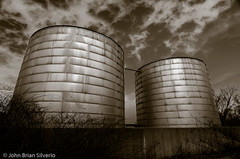 Image by psilver (silverph) via Flickr
Image by psilver (silverph) via Flickr
Is Tank Rainwater a Good Way to 'Go Green'? by M De Rooy
Water is a limited natural resource and quality tank rainwater is fundamental for life and health in many areas of Australia let alone other countries in the world. "The human right to water is indispensable for leading a life in human dignity. It is a prerequisite for the realization of other human rights" (United Nations 2002).
Australia is the world's driest continent and fresh water is a limited and valuable commodity. Over 90 per cent of Australians receive their domestic supply from reticulated mains or town water but there are vast areas with few reticulated supplies (Australian Bureau of Statistics 2001). Living and surviving in these areas is dependent on tank rainwater or other water supplies collected generally in tanks or dams.
Even in areas that receive mains water, many households use domestic tank rainwater to augment supplies or provide an alternative and renewable source of water. Widespread water restrictions have highlighted the importance of water conservation measures, including use of rainwater tanks.
The decision about how to use tank rainwater is a matter of personal choice. In making this decision, it should be recognized that, although the risk of contracting illness from tank rainwater supplied from well-maintained roof catchments and tanks is low, the quality of water from household tanks is not as consistently high as that provided by well-managed urban water supplies. Microbiological quality is not as reliable as mains water, particularly after rain events.
In addition, there are a few areas where impacts from major industrial emissions (for example, Port Pirie, South Australia) mean tank rainwater is not suitable for drinking and food preparation. The impacts on tank rainwater of very large densities of traffic, and other emissions, in Sydney and Melbourne are yet to be determined hence water agencies such as Sydney Water are reluctant to encourage people to consume tank rainwater.
One option to decrease any potential risk from tank rainwater is to minimize oral exposure by limiting use of the collected water to supplying hot water services, bathing, laundry, toilet flushing or gardening (that is, not for drinking or food preparation). The water quality requirements for non-potable uses are lower than those for drinking water.
Health hazards for tank rainwater can be minimized by sensible management procedures. With the possible exceptions of traffic emissions in urban areas, and industrial emissions, these hazards are within the control of most individuals. The implementation of a relatively low-key management approach will generally prevent most problems. A large first flush rank rainwater diverter is a first step of action. There is some evidence that the first flush of water in a rain event washes the roof catchment and hence may contain higher than average amounts of accumulated dust, bird and animal droppings, leaves and other debris (Coombes et al. 1999, 2002b; Yaziz et al. 1989).
Common sense maintenance of roof catchments, guttering, piping and rainwater tanks are relatively simple to carry out to ensure quality tank rainwater. First flush devices should be regarded as an additional barrier to reduce contamination and should not be used to replace normal maintenance activities designed to keep roof catchments reasonably clean.
The amount of tank rainwater required will depend on the number of people using the water, the average consumption per person etc against the range of uses required (drinking, food preparation, bathroom, laundry, toilet, size and type of the garden etc).
If the rainwater tank is to represent the only source of potable or domestic water, cost will be less important than the size of tank required. The amount of rain combined with the roof catchment area will determine the volume of water collected. A number of water conservation measures could be applied, including dual flush toilets and water efficient devices, such as reduced-flow shower-heads, washing machines with suds savers etc.
Tank rainwater can help you achieve a real difference in creating a sustainable environment in practical ways. When you install a Coastline Plastics Water Tank, rainwater saving is just one way you can impact your own patch. It is quite common from this small beginning; you'll be inspired to consider other more sustainable practices.Article Source: http://EzineArticles.com/?expert=M_De_Rooy
http://EzineArticles.com/?Is-Tank-Rainwater-a-Good-Way-to-Go-Green?&id=2402696
http://thezeitgeistischanging.blogspot.com/
http://psychedelichippiefashion.blogspot.com/
http://psychedelichippiemusic.blogspot.com/
http://www.soul-flower.com/Merchant2/merchant.mvc?Screen=SFNT&Store_Code=SOS&AFFIL=Robert_Muller
No comments:
Post a Comment